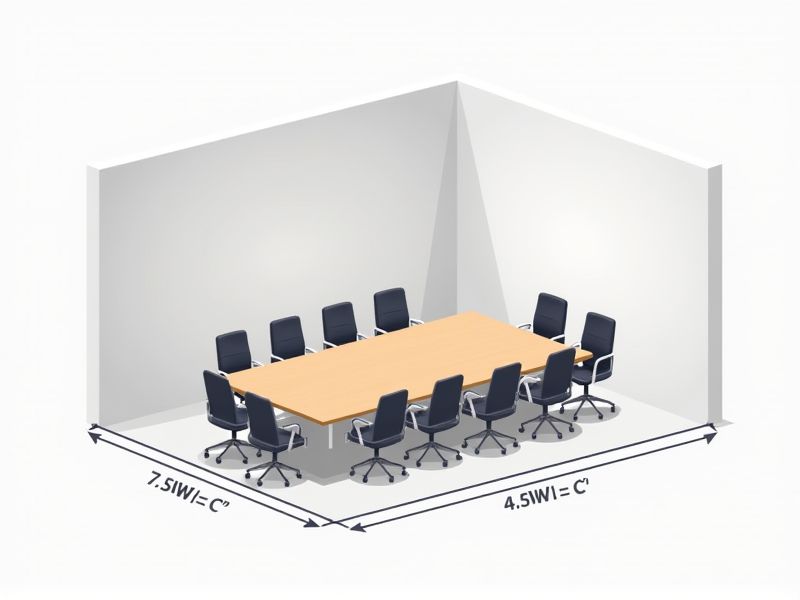
When choosing the standard dimensions for a conference room, consider the number of participants you need to accommodate. For example, a small conference room for 6-8 people typically measures around 12 x 16 feet (3.7 x 4.9 meters). Medium-sized rooms for 10-12 attendees often range from 15 x 20 feet (4.6 x 6.1 meters), while larger conference rooms designed for 20 or more people may be 20 x 30 feet (6.1 x 9.1 meters) or bigger. Tailoring your conference room size to your specific needs ensures comfort, accessibility, and effective communication during meetings.
Room Capacity Guidelines
Room capacity guidelines suggest that a conference room should ideally accommodate 10-12 square feet per participant for comfortable seating arrangements. For example, a room with a size of 300 square feet can effectively seat around 25 individuals, allowing for sufficient space for movement and technology. Ensuring that the table setup promotes interaction, a U-shape or circular arrangement encourages participation among all members. To optimize functionality, consider the available audiovisual equipment, which can enhance presentations and discussions in rooms designed for larger groups.
Seating Arrangements
Seating arrangements in a conference room significantly impact collaboration and interaction during meetings. For optimal engagement, consider a U-shape layout accommodating 12-20 participants, allowing for open dialogue and direct eye contact. Alternatively, a circular arrangement promotes inclusivity for smaller groups of 6-10, fostering a more intimate atmosphere. When planning your next gathering, remember that ergonomically designed chairs can enhance comfort, potentially increasing productivity by up to 25%.
Ceiling Height
The ideal ceiling height for a conference room typically ranges from 9 to 12 feet, enhancing spatial perception and promoting effective communication. Higher ceilings can facilitate better acoustics, reducing sound reflection and ensuring that voices carry clearly across the room. For a standard conference layout accommodating 10 to 20 participants, a minimum of 10 feet is recommended to prevent a cramped feeling and improve overall comfort. Incorporating elements such as sound-absorbing materials and strategically placed lighting can further optimize the room's functionality and atmosphere.
Door Width And Height
The standard dimensions for conference room doors typically are 36 inches wide and 84 inches tall, allowing ample space for easy entry and exit. A door width of 42 inches is recommended for high-traffic areas or facilities accommodating individuals with disabilities, ensuring compliance with ADA regulations. The height should ideally be at least 80 inches to provide comfortable passage for all attendees. When designing your conference room, these dimensions contribute to functionality, accessibility, and overall user experience.
Table Dimensions
The ideal conference room table dimensions typically range from 6 to 8 feet in length and 30 to 48 inches in width, accommodating up to 8-10 participants comfortably. For larger meetings, tables measuring 10 to 12 feet long can host 12-14 people, promoting effective collaboration and communication. The height of the table should be around 28 to 30 inches, aligning with standard chair heights, ensuring ergonomic comfort during discussions. This thoughtful design not only enhances user experience but also contributes significantly to the overall productivity of meetings.
Aisle Width
A conference room design typically emphasizes an aisle width of at least 36 inches to ensure easy movement and accessibility. This measurement facilitates comfortable navigation, allowing participants to enter and exit without disruptions. Furthermore, maintaining this standard promotes safety, as it ensures compliance with building codes and emergency evacuation protocols. To enhance your conference experience, consider furniture arrangements that respect this aisle width, creating an inviting and functional atmosphere for collaboration.
Space For Av Equipment
A conference room designed for optimal audiovisual (AV) equipment usage should ideally measure at least 300 square feet, ensuring ample space for screens, projectors, and sound systems. The room's layout should facilitate a clear line of sight from all seating positions to the primary display, enhancing visibility for all participants. Proper acoustics are crucial, with sound-absorbing materials reducing echo and background noise, which can affect communication quality. You should also consider integrating flexible furniture arrangements to accommodate various meeting types, from small workshops to larger presentations, maximizing functionality and user experience.
Electrical Outlet Placement
The strategic placement of electrical outlets in a conference room is crucial for facilitating seamless connectivity and efficiency during meetings. Ideally, an outlet should be positioned within 6 feet of each participant's seating area to ensure access for laptops and other devices. For larger rooms, a minimum of 4 to 6 outlets along perimeter walls is recommended to accommodate varying configurations. You'll enhance productivity by incorporating USB charging ports alongside standard outlets, promoting a clutter-free environment.
Natural Lighting Considerations
Natural lighting in conference rooms significantly enhances productivity and wellbeing. Studies show that workplaces with ample natural light can increase employee satisfaction by up to 24% and lead to a 15% increase in performance. Incorporating large windows, skylights, or glass walls not only allows for daylight to flood the space but also improves the aesthetic appeal. Aim for a balance of light and shade to reduce glare on screens while maximizing energizing daylight throughout the room.
Hvac Requirements
The HVAC requirements for conference rooms typically emphasize maintaining a temperature range of 68degF to 72degF (20degC to 22degC) for optimal comfort and productivity. Proper ventilation is crucial; the American Society of Heating, Refrigerating and Air-Conditioning Engineers (ASHRAE) recommends an air exchange rate of at least 15 CFM (cubic feet per minute) per person. Humidity levels should be controlled between 30% and 60% to ensure air quality and prevent discomfort. When designing your conference room, integrating advanced control systems for HVAC can enhance energy efficiency while accommodating varying occupancy levels and equipment loads.
